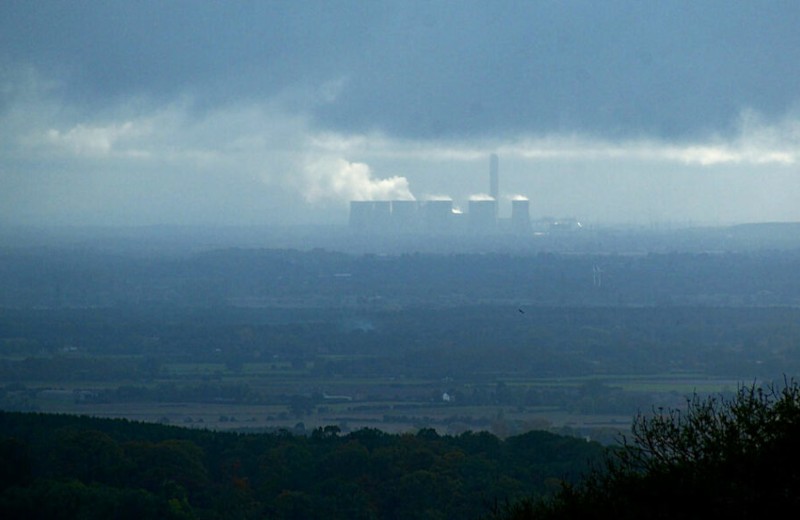Biomass power stations in the UK are in receipt of a huge tax break, based on an outdated assumption that burning wood is carbon neutral. In fact, UK billpayers are now committed to supporting unsustainable wood-based electricity generation to the tune of more than £13 billion, including £10 billion alone for the Drax power station in Yorkshire . In addition to direct subsidies, our new research at Ember estimates that biomass generators are receiving carbon tax breaks of £333 million a year.
Now the UK has left the EU there’s an opportunity to reassess carbon pricing – including in the design of the UK emissions trading system. As other countries consider biomass as a bridge out of coal, the UK can send an international signal that biomass must no longer be assumed to be carbon neutral.
Unlike other large thermal generators, biomass power plants do not pay for their carbon emissions. This is because biomass is assumed to be inherently carbon neutral under the EU Emissions Trading System and the UK Carbon Price Support. That assumption, however, is not supported by the weight of recent science, or by data provided by power plant operators themselves.
Tax breaks
The carbon tax exemption means biomass generators are receiving an unfair tax-break, diverting much needed funds away from other renewable sources which are guaranteed to be low-carbon. Using a mid-range estimate for biomass carbon intensity, we estimate the carbon tax break to large UK biomass power stations will be £333 million next year (£246m at Drax alone).Current sourcing rules for biomass allow for a large range of possible carbon outcomes, which leads to uncertainty as to how high the tax break is. At higher-end estimates of biomass emissions, the tax break could be up to £754 million a year (£557m at Drax alone).
- Since Drax began burning biomass for power generation in 2012, our mid-range estimate shows the government has already forgone around£1 billion in carbon taxes.
- Over the entire period over which subsidies are available to burn biomass (2012-2027), the government will forgo £2.8 billion in carbon taxes (on a mid-range estimate which assumes the UK’s post-Brexit total carbon price remains at the 2019 average). On a high-end estimate, the UK could forgo up to £6.4 billion.
Direct subsidy
This tax break is in addition to direct subsidies: this report finds subsidies to large biomass power plants will cost the energy billpayer more than £1 billion this year – or almost £3 million a day. Up until most subsidies are due to end in 2027, we calculate UK energy billpayers will spend £13 billion in direct support to large biomass power plants (including £10bn at Drax alone). This figure is all the more extraordinary considering wind and solar generation is now effectively subsidy free, and guarantees real emissions reductions.
The government is now considering further multi-billion subsidy for biomass with carbon capture and storage (BECCS) in pursuit of the UK’s net zero emissions goal. This research argues that biomass cannot be assumed to be carbon neutral, and so by extension BECCS projects are not guaranteed to deliver negative emissions. The government must only support BECCS projects when a full life cycle assessment demonstrates they are net carbon negative within the decade – and that the cost of negative emissions is equivalent to other options.
The science: Why is biomass not inherently carbon neutral?
Gas and coal power plants in the UK pay for the CO2 they emit; both via the EU Emissions Trading System (EU-ETS), and the UK’s additional Carbon Price Support (CPS). Power plants that burn wood do not pay for their CO2 emissions under either scheme, as it has been assumed that burning wood is carbon-neutral.
In fact, burning wood releases more CO2 per unit of electricity generated than coal (due to the higher moisture content). The carbon-neutral status of wood rests on the assumption that the CO2 emitted by the power station is absorbed by forest growth at some point in the future. However, a vast body of scientific research indicates that burning wood cannot be assumed to be inherently carbon-neutral. We discuss this further in the full report.

For comparison, Drax’s coal stack emissions are 898kg CO2eq per MWh (supply chain emissions are not reported).
“Subsidies to large biomass power plants will cost the energy billpayer more than £1 billion this year – or almost £3 million a day.”
Solutions
Biomass
- The government must abandon the assumption that burning wood for power is inherently carbon neutral.
- The government should work urgently to remove the biomass carbon tax break.
- To do so, UK carbon pricing will need to account for the net carbon emissions from biomass power stations measured on a full life cycle basis vs. a counterfactual with no bioenergy. Emissions should be calculated on Paris-relevant timescales (e.g. 10 years).
- To start to restore confidence in biomass, the onus is on biomass power plants to provide independently verified full lifecycle assessments of their feedstock carbon intensity over Paris-relevant timescales (for instance, 10 years) – vs an counterfactual in the absence of their activities. This can then be subject to a carbon price.3
- The government should further tighten the sustainability criteria to drastically reduce the risk of high carbon biomass sourcing. The CCC has already set out a number of immediate steps that need to be taken to improve the current sustainability framework. Sustainability criteria should be applied to all biomass sourcing – not only subsidised projects.
Biomass Energy with Carbon Capture and Storage (BECCS)
- Biomass is not inherently carbon neutral, therefore, BECCS projects cannot be assumed to be inherently carbon negative.
- The government must only support BECCS projects when a full life cycle assessment demonstrates they are net carbon negative within Paris-relevant timescales (e.g. a decade) – and that the cost of negative emissions is equivalent to other options.
- Nature based solutions (such as afforestation and restoration) which do not burn wood can deliver negative emissions now at low cost and risk – the UK must begin to deploy at scale immediately.
Phil Mcdonald is an analyst at Ember. He has worked on the UK 2035 gas phase-out, UK carbon pricing after Brexit, and industrial CCS and BECCS (biomass with carbon capture and storage).
This article was originally published on the Ember website.




